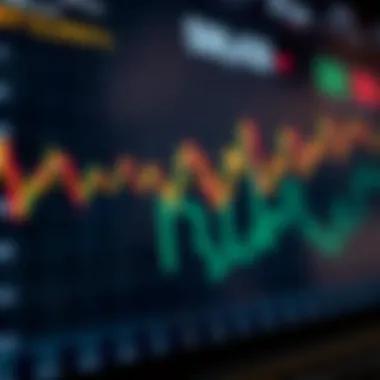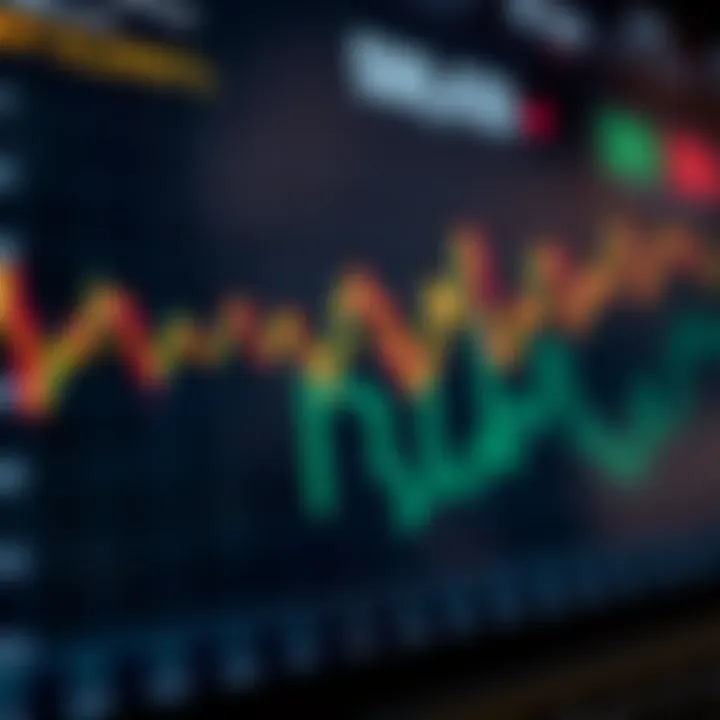Understanding Euro to Dollar Conversion Dynamics


Intro
Navigating the waters of currency conversion is no small task, especially when moving between euros and dollars. At the heart of this exchange lies a complex web of factors that dictate how much one currency is worth in relation to another. Whether you are a seasoned investor looking to diversify your portfolio or a novice venturing into the world of international transactions, understanding these intricacies is crucial. This article delves into the essential aspects of euro to dollar conversions, offering insights into the economic influences at play, the methods for executing conversions, and the implications of currency fluctuations for your financial endeavors.
Investment Terminology
To grasp the nuances of currency conversion, it's essential to familiarize oneself with some foundational investment terminology. Understanding the specific language used in financial markets can greatly enhance your ability to analyze trends and make informed decisions when converting euros to dollars.
Key Terms and Definitions
- Exchange Rate: The value of one currency for the purpose of conversion to another. For example, if the exchange rate is 1.2, it means one euro can be exchanged for 1.2 dollars.
- Spot Rate: This is the current exchange rate for immediate transactions. It reflects what you would pay in the market at that very moment.
- Forward Rate: This rate applies to contracts that will be executed at a future date, allowing businesses and investors to lock in a price for currency exchange ahead of time.
- Currency Pair: A quotation of two different currencies, with the value of one currency being quoted in terms of the other. For example, EUR/USD would be a pair comparing euros against dollars.
- Pip: The smallest price move that a given exchange rate can make based on market convention. Pip stands for "percentage in point".
Common Acronyms in Finance
- FX: Foreign Exchange, the market where currencies are bought and sold.
- USD: United States Dollar, the official currency of the United States.
- EUR: Euro, the official currency of the Eurozone.
- GDP: Gross Domestic Product, a monetary measure used to gauge the economic performance of a country.
- ECB: European Central Bank, responsible for monetary policy in the Eurozone.
Familiarity with these terms lays the groundwork for a deeper understanding of how conversion rates work and what factors may influence them.
Expert Insights
Financial experts and advisors often weigh in on strategies that can help individuals navigate the conversion landscape. Here are some commonly shared insights that could enhance your approach to converting euros to dollars.
Investment Strategies Overview
- Monitoring Economic Indicators: Keeping an eye on economic reports like inflation rates, employment statistics, and interest rates can provide hints about the direction exchange rates may take.
- Using Hedging: Some investors utilize hedging strategies to protect themselves against adverse movements in currency exchange rates, thereby minimizing risks associated with currency fluctuations.
- Diversification: Consider diversifying your investments across different currencies to mitigate risks and take advantage of favorable exchange rate conditions when converting euros to dollars.
Tips from Financial Advisors
"Always be informed about geopolitical events that could affect currency stability. Markets react swiftly to such news, impacting conversion rates almost in real-time."
- Stay updated with the latest international news. Economic policies, trade deals, and political climate can have significant implications for currency value.
- Make use of reputable currency converters, and compare rates among different financial institutions to find the best deal.
- Be mindful of the fees involved in conversion, as they can eat into your profits if not accounted for.
By incorporating these strategies and expert tips into your currency conversion practices, you enhance your potential to navigate the complexities of exchanging euros for dollars successfully.
Prelude to Currency Conversion
Navigating the maze of currency conversion is a fundamental skill, especially in an increasingly globalized world. Currency exchange not only fuels international trade and tourism but is also pivotal for investments and financial planning. Grasping the nuances of conversion between euros and dollars unlocks a deeper understanding of economics and personal finance. This knowledge is essential for anyone enthusiastic about making informed decisions.
Importance of Currency Conversion
In the world of finance, failing to grasp currency conversion is like driving with your eyes closed. Currency conversion is crucial for several reasons:
- Global Trade: Businesses deal in various currencies while executing transactions across borders. Proper conversion techniques can help them execute deals at favorable rates.
- Travel: Whether exploring the cobblestone streets of Paris or shopping in New York, tourists need to convert their currency to avoid losing out on their hard-earned cash.
- Investing: Investors looking for opportunities in foreign markets must understand how currency value affects their potential returns.
The importance of currency conversion extends beyond mere numbers. It connects individuals to the global market, enabling them to make well-informed choices. Keeping a finger on the pulse of foreign exchange can lead to smarter purchasing decisions.
The Role of Exchange Rates
Exchange rates act as the compass guiding currency conversion. They determine how much one currency is worth in terms of another and are influenced by various factors. Understanding this role is pivotal:
- Market Fluctuations: Rates can vary based on trader sentiment, speculation, and economic indicators. The continual shifts present opportunities for savvy traders but can also pose risks.
- Government Intervention: Central banks often intervene in foreign exchange markets to stabilize or adjust their national currency, impacting the rates significantly.
- Economic Health: Strong economic indicators (like low unemployment and high GDP growth) usually correlate with a robust currency, making conversions more favorable.
Exchange rates can feel like a roller coaster ride – dizzying and unpredictable. However, with a solid grasp of their dynamics, individuals and businesses can navigate this exhilarating experience more confidently. Understanding that these rates are not mere numbers, but reflections of economic realities, is essential for both daily transactions and strategic investments.
"Currency conversion isn't just about numbers; it's about unlocking potential in a globalized market."
As we delve deeper into the conversion between euros and dollars, we'll explore the intricacies of the factors influencing these rates and the methods for conversion. This understanding lays the groundwork for making intelligent decisions in today's fast-paced financial landscape.
Understanding Euros and Dollars
Understanding the conversion between euros and dollars is akin to opening a window into global commerce. It offers insight into not just currency values, but also the interplay of economic giants. The euro, representing the collective economies of multiple European nations, contrasts sharply with the US dollar, often seen as the global reserve currency.
For anyone engaging in international transactions, whether for business, travel, or investments, grasping these currencies' nuances can't be overstated. Knowledge of the euro and dollar exchange framework empowers individuals to make informed financial decisions, which is crucial in today’s interconnected marketplace.
Key considerations include:
- Exchange Rate Variability: Understanding how fluctuating rates impact conversion can save money.
- Economic Indicators: Being aware of indicators affecting each currency can enhance predictive capabilities regarding market shifts.
- Transaction Costs: Choosing the right time and method for conversions can minimize expenses and maximize returns.
Arming oneself with these insights not only enhances financial savvy but also builds confidence in navigating the complexities of global finance.
Overview of the Euro


The euro is not merely a currency; it is a symbol of economic unity among European nations. Initially introduced in 1999 and fully rolled out in physical form by 2002, the euro has become the second most traded currency in the world, following the US dollar. This currency is used by 19 of the 27 European Union countries, known collectively as the Eurozone.
Each euro is divided into 100 cents, and the currency is denoted by the symbol €.
Factors to consider about the euro include:
- Economic Influence: The euro's value hinges on the economic stability of the Eurozone, which comprises diverse economies that are interlinked yet distinct.
- Central Bank Policies: The European Central Bank plays a crucial role in controlling inflation and stabilizing the currency, influencing market sentiment significantly.
- Global Acceptance: As a major trading currency, it has acceptance beyond Europe, affecting global trade agreements and commodity pricing, particularly in energy and agriculture.
Given these elements, the euro's strength or weakness can ripple through markets, affecting everything from consumer goods pricing to international investment returns.
Overview of the US Dollar
The US dollar, represented by the symbol $, is the world's primary reserve currency. Its importance cannot be overstated as it forms the backbone of international trade and is widely accepted across the globe. This currency accounts for about 60% of global foreign exchange reserves and is often considered a safe haven during economic turbulence.
The dollar’s status is upheld by several factors:
- Robust Economy: The strength of the US economy, marked by technological innovation and diverse industries, underpins the dollar's value.
- Federal Reserve Policies: The influence of the Federal Reserve, through monetary policy decisions, sets the tone for currency valuation and market stability.
- Global Demand: The dollar is in constant demand for international transactions, making it a staple in pricing commodities like oil, gold, and other resources.
In summary, understanding the foundational elements of the euro and the US dollar is key for anyone looking to enhance their grasp of financial markets. Their interplay creates a dynamic landscape that can lead to both opportunities and challenges for investors, travelers, and everyday consumers alike.
Factors Influencing Exchange Rates
When looking at how euros convert to dollars, it’s essential to grasp the factors influencing exchange rates. Exchange rates don't just fluctuate randomly; they're shaped by various internal and external elements. Understanding these factors is crucial for making informed decisions, whether you're a seasoned investor or just dipping your toes into international finance.
Economic Indicators
Economic indicators are perhaps the most tangible aspect to consider when thinking about currency value. Indicators like GDP, unemployment rates, and inflation all play a significant role in determining how strong or weak a currency might be against another. For instance, if the eurozone shows robust economic growth compared to the American economy, you might notice the euro gaining strength against the dollar.
- GDP: A rising GDP indicates a healthy economy, risking a stronger euro. Conversely, if the GDP is stagnant or declining, the euro might weaken.
- Inflation Rates: High inflation in the eurozone might weaken the euro as purchasing power decreases, while low inflation in the US could strengthen the dollar in comparison.
- Employment Data: High employment figures can boost investor confidence in an economy, increasing demand for that currency.
"Strong economic indicators lead to higher demand for a particular currency, while weak indicators can result in depreciation."
Investors and various entities need to keep an eye on these indicators, as they can dictate market movements, influencing when to buy or sell currencies.
Political Stability
The political landscape in both the eurozone and the United States significantly affects exchange rates. Stability and governance create a fertile ground for investment and economic growth.
- Political Events: Elections, referendums, or social unrest can create uncertainty which usually leads to depreciation. If investors fear instability, they often pull their investments out, weakening the currency.
- Government Policies: Fiscal and monetary policies from either the European Central Bank or the Federal Reserve can impact rates directly. Policies aimed at stimulating growth may boost currencies, while austerity measures could have the opposite effect.
A politically stable environment generally attracts foreign investors, leading to a stronger currency and a favorable exchange rate.
Market Sentiment
Market sentiment often acts as the 'wild card' in the game of currency exchange. Mood swings in the market—whether optimistic or pessimistic—have a profound impact on exchange rates.
- Investor Confidence: When investors feel bullish about economic prospects, they tend to invest more, which could lead the euro to appreciate against the dollar. Conversely, bearish sentiment could see a sell-off of euros, dragging its value down.
- Global Events: Natural disasters, geopolitical tensions, or significant market events can sway sentiment dramatically. For instance, if a major catastrophe hits Europe, the euro may weaken even if underlying economic indicators remain strong.
Understanding the currents of market sentiment is pivotal for anyone dealing with currency exchange; it’s the emotional aspect that can lead to abrupt changes in exchange rates.
In sum, factors influencing exchange rates are varied, complex, and ever-changing. Investors and currency users alike must stay informed about these drivers to effectively navigate the tricky waters of currency conversion.
Methods for Currency Conversion
When it comes to converting euros to dollars, understanding various methods for currency conversion becomes pivotal. In an increasingly globalized economy, knowing how to efficiently handle currency exchange can save you a lot of money. Moreover, the right method can help you make better investment decisions or enhance your travels abroad. Let's dive into the specific techniques that can assist you in this vital financial activity.
Manual Conversion Techniques
Manual conversion techniques involve calculating the exchange rate on your own, which means not relying on any digital tools. This method could be particularly useful in situations where you may not have internet access or in places where exchange services charge steep fees. Basically, you take the amount in euros and multiply it by the current exchange rate to arrive at the dollar equivalent.
For instance, if one euro equals 1.10 dollars, to convert 100 euros, you would calculate:
[ 100 \times 1.10 = 110 \text dollars ]
While this method might sound straightforward, it does have its drawbacks. Rounding errors or outdated exchange rates can easily lead to miscalculations. Additionally, it can be a bit cumbersome if you're dealing with large or fluctuating amounts. However, understanding the manual approach provides a solid grounding in currency conversion fundamentals.
Utilizing Online Currency Converters
In today's digital age, online currency converters have become a go-to resource for many, offering a quick and efficient way to convert euros to dollars. Websites like XE or OANDA provide real-time exchange rates that reflect market conditions, thus making the conversion process much simpler and reliable.
These platforms usually allow you to enter the amount you wish to convert and automatically provide the updated figure in the target currency. This method is particularly advantageous for travelers or investors who need to stay updated on fluctuating rates without diving deep into the numbers.
Some advantages of using online tools include:


- Speed: Instant calculations save time.
- Accuracy: Access to current rates minimizes errors.
- Ease of Use: User-friendly interfaces are generally easy to navigate.
While online converters are quite handy, it's wise to double-check the rates displayed with your bank or exchange service. There can be hidden fees or less favorable rates applied during the actual currency exchange.
Mobile Applications for Currency Exchange
Mobile applications designed for currency conversion have added another layer of convenience in managing exchanges. Apps like XE Currency and Currency Converter Plus put the power of conversion literally at your fingertips. They often feature real-time updates and can even work offline with previously downloaded rates.
Using mobile applications offers a myriad of benefits, such as:
- Convenience: Access your conversion tool anywhere.
- Customization: Many apps let you save your favorite currencies for quick access.
- Alerts: Set up alerts for rate changes to catch the best deals.
For example, if you're an investor watching the euro-dollar exchange rate closely, you can receive notifications when the rate reaches your desired threshold—such a feature can be a game changer. Moreover, apps usually supply historical data, enabling users to track trends over time, which is essential for making informed investment decisions.
Having a good grasp of the available methods for currency conversion can empower you to make more informed choices, regardless of whether you're traveling, investing, or simply managing your finances.
In sum, each method—manual calculations, online converters, and mobile applications—has its pros and cons. Depending on your needs and circumstances, the ideal approach may vary, but being familiar with all can only enhance your skill set in navigating international money matters.
Conversion Charts for Quick Reference
In the realm of currency exchange, having quick access to conversion charts can make a world of difference. These charts serve not only as a helpful tool for day-to-day transactions but also assist in strategic financial planning. For individuals looking to convert euros into dollars, conversion charts offer clarity and save valuable time in navigating fluctuating exchange rates. They present a side-by-side comparison that is simple to understand, which is especially beneficial for beginners who may feel overwhelmed by the complexities of currency conversion.
- Ease of Use: Conversion charts provide an intuitive way to see the real-time exchange rate at a glance.
- Time-Saving: With a conversion chart, you can quickly find how much 50 euros equals in dollars without fiddling with a calculator or online converter.
- Visual Representation: For visual learners, charts can make the abstract nature of currency value more concrete.
Moreover, knowing how to read these charts can empower users to make informed decisions. They help in identifying favorable conversion rates at a glance, thus allowing for timely transactions based on personal financial needs or investment strategies.
Understanding Conversion Charts
When diving into conversion charts, it’s helpful to understand the underlying principles that govern them. These charts plot various amounts of euros against their corresponding dollar values based on the current exchange rate. Typically, they are updated frequently, reflecting real-time market movements.
To utilize a conversion chart effectively:
- Identify the Amount: Start by determining the amount in euros that you wish to convert.
- Locate the Row: Find the row that corresponds to this amount.
- Read Across to Dollars: Follow that row horizontally to see its equivalent in dollars.
For context, let’s say the chart indicates that 1 euro equals about 1.15 dollars. If you're converting 100 euros, read across to find that it would approximately be 115 dollars.
It's essential to note that conversion rates can fluctuate, so it's wise to check the chart regularly to ensure your figures are up to date. Often, these charts also highlight historical trends, which can provide useful insights into how stable the currency has been.
Sample Conversion Chart (Euros to Dollars)
Here’s a simple sample conversion chart illustrating a few common amounts in euros converted to dollars. This can be particularly handy for quick reference:
| Euros | US Dollars | | 1 | 1.15 | | 10 | 11.50 | | 50 | 57.50 | | 100 | 115 | | 200 | 230 | | 500 | 575 |
Using such a chart allows for swift calculations and can play a critical role in enhancing one’s financial decisions, particularly when planning investments or budget allocations. While the fundamental principle remains the same, these conversion charts illustrate how varying amounts can significantly impact financial outlooks depending on the current exchange trends.
Exchange Rate Fluctuations
Understanding exchange rate fluctuations is crucial for anyone involved in or interested in international commerce, travel, or investment. These fluctuations can significantly impact your purchasing power, investment returns, and overall financial strategy. Knowing how these rates shift can help you make informed decisions, whether you're converting euros to dollars for a purchase abroad or investing in foreign assets.
Why Fluctuations Matter
- Impact on Purchasing Power: When the exchange rate shifts, the value of your currency also changes. If the euro weakens against the dollar, it’ll cost you more dollars to buy the same goods or services priced in euros. Conversely, a stronger euro means you can buy more with fewer dollars.
- Reflects Economic Health: Fluctuations in exchange rates often symbolize broader economic trends. A rapidly declining euro may point towards economic challenges in the Eurozone, such as high unemployment or inflation. Understanding these indicators can lead to better financial planning.
- Investment Returns: For investors, exchange rate changes can impact the returns on international investments. A favorable fluctuation can enhance gains, while adverse moves can eat into profits or worsen losses.
"Currency is like water; it flows and changes shape with the environment it’s in. Knowing how to steer through those changes is key to securing one’s financial future."
Historical Trends
The historical performance of the euro against the dollar presents a fascinating backdrop to current fluctuations. Over the years, various global events—including economic crises, changes in interest rates, and geopolitical developments—have influenced the exchange rate. For example, during the 2008 financial crisis, the euro experienced significant depreciation against the dollar, largely due to fears surrounding the European banking sector.
Several noteworthy trends can be identified:
- 2008 Financial Crisis: The euro fell sharply as investors flocked to the safety of the dollar during the economic downturn.
- Post-Crisis Recovery: In the years following the crisis, the euro regained strength as the European economy began to recover, leading to a more favorable exchange rate.
- COVID-19 Pandemic: The pandemic brought about new challenges, with fluctuations driven by economic uncertainty, government responses, and stimulus measures taken in the Eurozone and the U.S.
These historical patterns serve as a window into potential future movements but must be interpreted with caution.
Current Trends and Predictions
As for current trends, analysts are keeping a keen eye on both regional and global developments. Presently, the euro faces challenges from inflation and energy prices, making it vulnerable against the dollar. On the other side, the U.S. dollar has benefitted from a robust labor market and Federal Reserve policies aimed at curbing inflation.
Short-Term Predictions:
- Increased volatility is expected as economic data and geopolitical tensions fluctuate.
- Predictions suggest potential dollar strengthening if inflation remains high in the Eurozone.


Long-Term Outlook:
- Some economists believe that as the European Central Bank addresses inflation, the euro may rebound.
- Others caution that structural issues in the Eurozone could keep the euro under pressure.
Awareness of these trends allows individuals and investors to anticipate changes and make proactive decisions regarding their currency exchanges, investments, and financial planning.
The Impact of Inflation
Inflation plays a significant role in currency conversion, particularly when it comes to understanding the exchange rate between euros and dollars. It affects purchasing power, influences interest rates, and alters investment strategies. With inflation, the worth of a currency can shift dramatically, leading to increased costs for both goods and services. Therefore, grasping the concept of inflation is essential for anyone engaging in international transactions or investment decisions.
Why Does Inflation Matter?
Inflation impacts how much you can buy with your money. If prices increase steadily, a euro or dollar will buy less over time. This can be particularly pronounced when comparing economies. Not only does inflation affect day-to-day living, it can also influence larger financial constructs, such as mortgage rates or the costs associated with international travel. In essence, understanding inflation equips investors with the necessary insights to make informed decisions when converting euros to dollars, especially during volatile economic periods.
Understanding Inflation in Economies
Inflation is measured by how much the general price level of goods and services rises over a specified period. In simpler terms: when you say prices are climbing, you're talking about inflation. Central banks, including the European Central Bank and the U.S. Federal Reserve, often adjust monetary policies based on inflation rates.
Key Points About Inflation:
- Types of Inflation: Demand-pull inflation occurs when demand outpaces supply. Cost-push inflation is when prices rise due to increased costs of production. Both can impact currency values significantly.
- Consumer Price Index (CPI): This is a common measure used to calculate inflation. It tracks changes in the price level of a basket of goods and services, giving a snapshot of inflationary trends.
- Hyperinflation: This extreme case occurs when inflation spirals out of control, drastically undermining a currency's value. Examples of hyperinflation can be seen in historic case studies like Zimbabwe or Venezuela, where the purchasing power collapsed.
In an ever-globalizing world, investors must keep a close eye on inflation rates in the eurozone versus the U.S. For instance, if the eurozone experiences higher inflation relative to the U.S., the euro may depreciate against the dollar, making conversion more expensive.
Comparative Inflation Rates
When looking at currencies, it's paramount to compare inflation rates between the euro and dollar economies. These comparisons can influence exchange rate expectations and investment decisions.
Some Factors to Consider:
- Current Rate Comparisons: Regularly check inflation statistics published by credible sources such as the U.S. Bureau of Labor Statistics or the European Central Bank. These resources provide up-to-date data.
- Historical Inflation: Historical inflation data offers insights into trends and can indicate how future conversions may be affected. A period of high inflation in one economy can suggest upcoming shifts in currency value.
- Impact on Trade Balances: A higher inflation rate typically implies higher prices for exports, impacting trade balances and subsequently affecting currency strength.
"Understanding inflation helps you navigate the stormy waters of international currency conversion. Without it, you may find yourself adrift."
Practical Considerations in Currency Conversion
When it comes to converting euros to dollars, practical considerations become fundamental. It's not just about knowing the exchange rate; various elements come into play that can significantly affect the efficiency and cost of your currency conversion tasks. This aspect of currency conversion serves as a roadmap, guiding both novice investors and seasoned financiers.
Choosing the Right Time for Conversion
Timing can be everything. When you decide to convert your euros to dollars could mean the difference between losing or saving money. Exchange rates fluctuate for a multitude of reasons: economic news, geopolitical events, and changes in monetary policy influence the market.
To be savvy about your currency conversion:
- Stay Informed: Regularly check updates on financial news platforms. Knowing what is happening globally can help you predict shifts in exchange rates.
- Historical Analysis: Understanding past trends can provide insight. For example, if you notice that the rate tends to dip around a certain time of year, you might want to plan your conversion accordingly.
- Set Alerts: Several currency converter services allow you to set alerts for specific rates. This way, you do not have to constantly monitor the market; you’ll get notified when the conditions are favorable.
By being attentive to these factors, you can optimize your conversion decisions and possibly gain a better return on your euros.
Minimizing Conversion Costs
Conversion costs can sneak up on you. Knowing how to effectively minimize these expenses is a significant part of your strategy. These costs may include transaction fees, service charges, and even poor exchange rates provided by some services. Here are a few tips to keep your expenses in check:
- Compare Services: Before making a conversion, compare various financial institutions and money transfer services. Some banks might offer better rates than others.
- Avoid Airport Exchanges: Airports are usually the worst places to convert money. Exchange services there often charge steep fees and provide unfavorable exchange rates.
- Use Online Platforms: Consider reputable online platforms like Wise or Revolut which usually offer lower conversion rates and transparent fee structures.
- Bulk Conversions: If you know you'll need to convert a large amount, doing so in one go rather than multiple smaller conversions can save you money on repeated fees.
"Planning ahead can often spare you from unnecessary costs in the currency conversion process."
By giving attention to the timing and minimizing costs, you not only become a more effective money manager but also build a solid foundation for making international transactions and investments smoother and more informed. Understanding and acting on these practical considerations can significantly enhance your financial outcome.
The End
In any financial discourse, the conclusion often serves as the backbone of the discussion, linking previous insights and paving the way for future considerations. The conversion from euros to dollars is no exception. It is crucial to understand how the dynamics of exchange rates, inflation, and economic factors interweave to influence these currencies’ conversion.
Summarizing Key Insights
A successful currency conversion isn't just about numbers; it’s surrounded by a web of economic implications. Key insights that stand out from this article include:
- Currency Values Fluctuate: Exchange rates are not set in stone. Factors like geopolitical events or shifts in economic outlook can affect them daily.
- Costs Involved: Conversion isn’t merely about changing currency; it involves fees often unnoticed but impactful. Always be aware.
- Timing Matters: Choosing the right time to execute a conversion can lead to better financial outcomes, thus improving the overall value received. Timing makes the world go round in this world of currency.
- Diverse Conversion Methods: Understanding manual methods and leveraging digital tools, like apps or online services, can save time and minimize conversion costs. Each method has its place and can cater to distinct needs.
These insights not only illuminate the path for beginners but also act as checkpoints for seasoned investors aiming to reinforce their strategies in a fast-paced financial environment.
Future of Currency Conversion
The future of currency conversion is not static; it is evolving even as we speak. With the rise of technology and digital currencies, traditional methods of conversion might become outdated. Here are a few factors that could shape that future:
- Emergence of Cryptocurrencies: As more individuals and businesses turn to Bitcoin, Ethereum, and other digital currencies, how will this affect the traditional Forex market?
- Automated Trading Systems: These systems can analyze vast amounts of market data in milliseconds, allowing for shifts in conversion strategies based on real-time information, making the market more responsive than ever.
- Global Economic Policies: Central banks' decisions and international policies will continue to influence how currencies fare against one another. It’s a ballet of political and economic strategies.
- Increased Transparency: As technology advances, we may see more transparency in conversion rates, potentially leading to reduced fees and better public access to exchange information.
Ensuring that you stay informed about these developments will be key to mastering currency conversion in the coming years. Keep an eye on the trends and learn the ropes, because the landscape is forever changing, and your financial acumen must keep pace.
"Knowledge is power, especially in finance; don't let changes catch you off guard."
For further reading and resources, consider visiting Investopedia, Wikipedia, and financial forums such as Reddit to gain new perspectives and updates about currency conversion.















